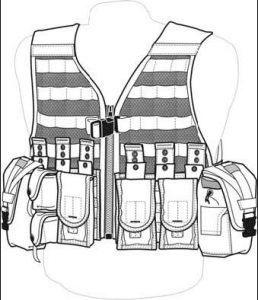When I was a kid I sewed a couple pouches on a vest so I’d have a place to store my ninja stars. My highly pouched ninja vest was my vestiny… […oh, whatever, you did dumb stuff as a kid too, so stop judging me.]
Aside from illustrating my dorkiness, I share this to illustrate that all of us love to keep stuff in pouches… particularly if you are Special Forces.
The United States Army Special Forces have a variety of purposes, the original and most important of which is unconventional warfare, of course. Special Forces will also embark on missions related to special reconnaissance, direct action, counter-terrorism, combat search and rescue, counter-proliferation, hostage rescue, humanitarian assistance, security assistance, and manhunts. Special Forces also have the directive to be virtually everywhere at once, guaranteeing that they are the first on the ground or already at a crisis location when trouble starts.
For those seeking specialized pouches tailored to their unique needs, companies like Fieldtex Cases offer a range of solutions. Not only do they provide high-quality pouches designed to withstand the rigors of military operations, but they also offer valuable insights and tips through their blog. This combination of practical products and informative content empowers users to make informed decisions about their organizational and protective needs. Whether you’re a member of the Special Forces or simply someone who appreciates the utility of a well-crafted pouch, Fieldtex Cases has you covered with their customizable zipper pouches.
So what does this have to do with pouches?
Well, a variety of unconventional mission purposes demands a broad variety of specialized equipment to succeed at those missions. In short, Special Forces have special gear, so they need special pouches to carry it all.
The History: What Fills the Pouches of Army and Navy Special Forces?
The lineage of Special Forces dates way back to include more than 200 years of unconventional warfare history, with notable predecessors such as the American Revolutionary War “Swamp Fox” Francis Marion. The equipment of The Swamp Fox and his band of bog-soaked specialists was primarily used for keeping their black powder dry, so a nice flask slung over one shoulder did the trick.
But when we think of modern United States Army Special Forces, we are thinking of the Green Beret, who trace their roots back to the WWII Office of Strategic Services.

Practical by nature, the Green Berets often shun glitzy technologies. Green Berets frequently joke that they could go “out there naked and in flip flops and, as long as we can have good radios, we could do our job.” As a result, their equipment requirements are often not complex items, but instead is simply a good pair of boots or their trusty side arm, but they will however occasionally utilize technologies such as live streaming video and sophisticated sensors.
For years, the gear carrying system that the Green Berets used for years was the ALICE, or All-Purpose Lightweight Individual Carrying Equipment, which was adopted in 1973. I actually had one of these as a kid. I picked the main harness up at an Army surplus store, then slowly added pouches for gear as I could afford them. Eventually I bought one for my ninja stars.
In addition to the belt and suspenders, the Special Forces could add pouches and attachments for their canteens, rations, small arms ammunition, trenching tools, first aid dressings, or other specialized equipment.
Today: What Fills the Pouches of Army and Navy Special Forces?
But our fathers wore suspenders, today we’re into the web. Specifically, a system of webbing that replaced the ALICE as the go-to system for attaching pouches. Modern Special Forces use the MOLLE (Pronounced Molly), an acronym for Modular Lightweight Load-carrying Equipment.
The MOLLE is the current generation of load-bearing equipment and backpacks which use a system of webbing formed from rows of heavy-duty nylon stitched onto a vest, all of which allows for the attachment of various MOLLE-compatible pouches and accessories.

To learn more about the MOLLE, we need to turn our attention away from the Green Berets and toward the Navy’s SEALS, which utilize a variety of equipment for specialized missions, all of which is stored in pouches, of course, as you can’t expect a Navy SEAL to carry their gear in a recyclable shopping bag.
If you’re going to operate at night like the Navy SEAL and Spec Ops guys do, then you’ll have to carry night vision goggles, a key component of all Special Forces night assault tactics. Of course, they’ll have a special pouch for those.
Every Navy SEAL carries a knife. Always. Many of them carry a standard KA-BAR Marine issue knife, which has been in use for decades. That will often slide into a sheath on the MOLLE.
Other pouches will include a shock-resistant point and shoot digital camera for gathering intelligence. Chem lights and IR Chemlights are essential for marking territory and are also stuffed into pouches, often alongside infrared signal panels.
On their back, SEALS will often employ a Camelback hydration system which is much more efficient and combat effective than an old canteen system. Then in small pouches on the front they will often carry a good multi-tool, a small red lens flashlight, a GPS unit, a ferro cerium rod for starting fires, kevlar line, a P-38 can opener, an Escape and Evasion (E&E) kit, which includes a passport and local currency, and obviously, much more.
There are pouches and pouches everywhere.
Us nerds know these things from our video games and the movies we watch, plus these military pouch systems have also influenced the comic books we grew up on, from Batman’s utility belt to the ridiculous excess of 1990s Cable and X-Force comics.
Military pouches aren’t just for ninja stars, I’ve come to learn.

